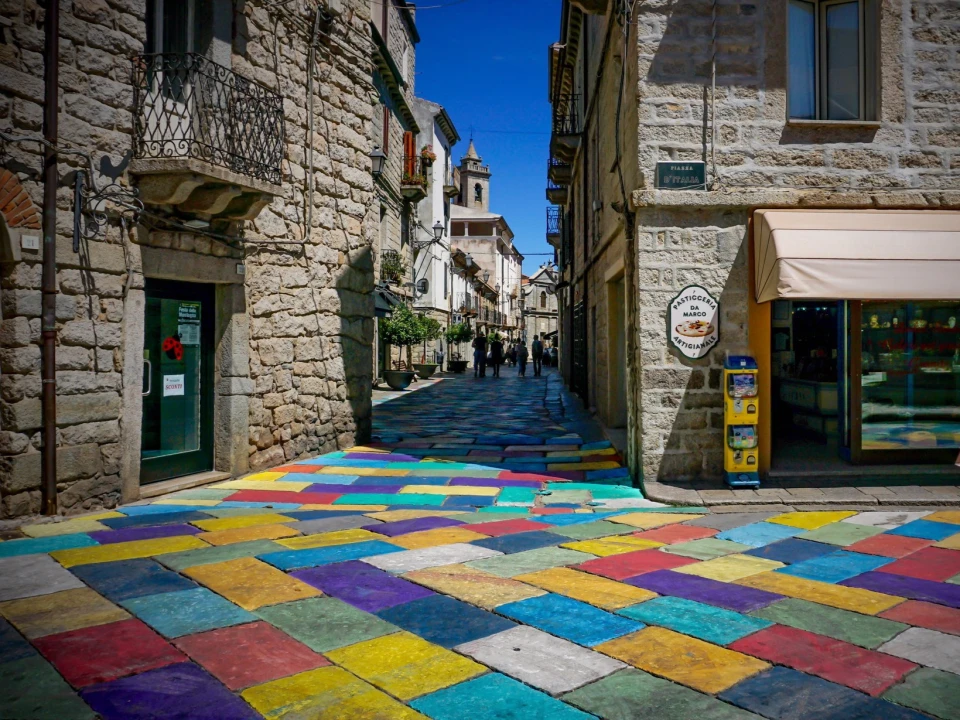Tempio Pausania, the "city of stone," is a jewel set in Mount Limbara. The ideal place to breathe pure mountain air less than 30 minutes from the sea and the island's most beautiful beaches. The old train station from the 1930s, with paintings by painter Giuseppe Biasi, is the arrival point of the "little green train" that crosses Gallura.
With its spring waters, unspoiled nature and characteristic historic center, today Tempio is one of the most interesting towns to visit in Sardinia. Tempio preserves in its splendid historic center of medieval layout, ancient buildings and granite squares. The 13th-century Cathedral of St. Peter the Apostle and the church of Santa Croce are accompanied by the Massidda and Sanguinetti palaces and the Carmine Theater, creating a timeless cityscape.
In the alleys of the historic center, Piazza Faber, dedicated to Fabrizio De André, stands out, with a colorful installation designed in collaboration with Renzo Piano.
Along with art, culture and tradition take center stage in the City of Stone: the Carnival of Tempio - Lu Carrasciali Timpiesu - is the most important allegorical carnival on the island, with more than a hundred thousand attendees each year.
Urban charm blends with natural charm in and around the city. The Rinaggiu springs, known since Roman times for healing properties, the holm oaks of the Parco delle Rimembranze or the numerous nuragic sites (the village of Mount Lu Finocchiu, the Giants' tombs and eleven nuraghi, including the Majori nuraghe and the Izzana nuraghe) are a prelude to the scenery of the Limbara Park, with its forests, waterfalls, countless walks and trekking routes.
Between thousand-year-old mountains and a contemporary spirit, the "City of Stone" welcomes with its contrasts. To arrive in Tempio is to immerse yourself in a unique experience between nature and culture.
In the heart of Gallura among woods and springs, rises Tempio Pausania, a village rich in history and millenary traditions, characterized by an evocative historic center built entirely in granite and for this reason also known as the "City of Stone."
Surrounded by green woods and vineyards, Tempio Pausania develops around a lively medieval historic center that preserves intact its ancient physiognomy.
In the immediate surroundings, Mount Limbara dominates northern Sardinia. From its peaks, which exceed 1300m above sea level, unique panoramic views can be admired. Thanks to its unspoiled nature and the CAI trail network, it is a paradise for hiking, trekking, biking and canyoning enthusiasts. The contemporary art museum in the Curadureddu forest is worth visiting.
Tempio Pausania is only 25km from the sea and the most beautiful beaches in northern Sardinia.
The name
The city's name comes from the Latin 'templum' ("temple"), probably because of the presence of an ancient pagan temple near the Cathedral. "Pausania" derives from "Phausania," a small settlement that has now disappeared, perhaps the original seat of the ancient ecclesiastical diocese.
History
The territory of Tempio Pausania tells a very ancient history that has its origins from the Neolithic age as evidenced by megalithic circles, dolmens, and nuraghi still well preserved and visitable today. Thanks to a territory rich in resources, Tempio Pausania assumes since its birth the role of city-guide and main reference point for all the small towns of the Gallurese hinterland.
In 1300, the city of Tempio is referred to as "Villa Templi" as a rural center of the Giudicato of Gallura, serving as the seat of the curator of the territorial district of Gemini. In 1506, Tempio became an episcopal seat. In 1837, King Charles Albert of Savoy granted Tempio, capital of a vast province and seat of a prefecture, the honors of City Hall and the administrative dignity of "city."
In the early twentieth century there was a sharp increase in population due to the gradual abandonment of the stazzi - the typical Gallurese rural settlements - towards the city, with unprecedented building growth.
Today Tempio Pausania is one of the most industrialized cores on the island, a renowned center of artisanal and industrial processing of raw materials such as granite and cork and of wine production.
The village retains its charm intact thanks to the charming medieval old town. Where the 17th-century Capuchin convent once resided, the Town Hall and Gallura Square now stand. Next to it stands the cathedral of St. Peter the Apostle, built in the early 13th century, then enlarged and renovated, and was reconsecrated in 1839. In the historic center, among the civic buildings, the medieval residence attributed to Nino Visconti, judge of Gallura and friend of Dante, mentioned in the 8th canto of Purgatory, the former Mercato (1663), which was first a prison then a market, the 17th-century Scolopi convent, stand out, the typical palaces with their exposed stone facades, the oldest of which were built by the local nobility between 1600 and 1700, the Teatro del Carmine (early 1900s), the Art Nouveau train station with paintings by painter Giuseppe Biasi, but also evidence of Tempio's more recent history. Prominent among the ancient granite-paved alleys is Faber Square, named after Fabrizio De André, who had chosen Tempio as his place of choice.
Typical dishes of the village
Suppa cuata, typical Gallurese soup made with bread, broth and cow's cheese. Mazza frissa, a poor dish of local tradition made with cream. Acciuleddi, braids of fried dough covered with honey and orange zest. Frisgioli longhi, the long fritters typical of Carnival. Panafittas, a poor dish of the Contandina tradition made from stale bread. Casgiatini, traditional Easter sweets made with cheese
Typical products of the village
Cork: Gallura's most precious natural resource, it is processed in Tempio for the production of corks, gifts and textiles.
Granite: quarrying of the typical local stone - pink granite and gray granite - exported all over the world.
Wines: in the numerous vineyards in the municipal area, the centuries-old tradition of wine production is continued. Among the typical wines: vermentino, muscat, cannonau and sparkling wine.




